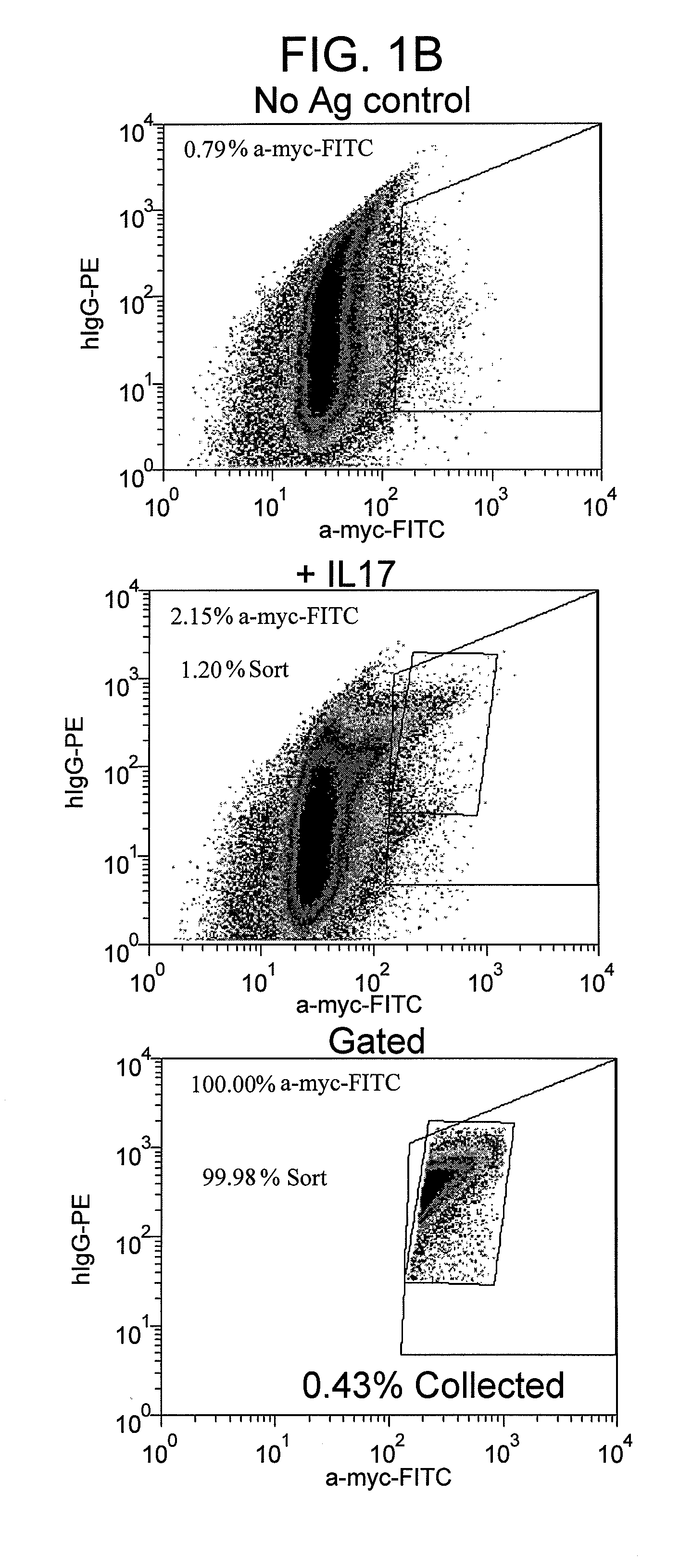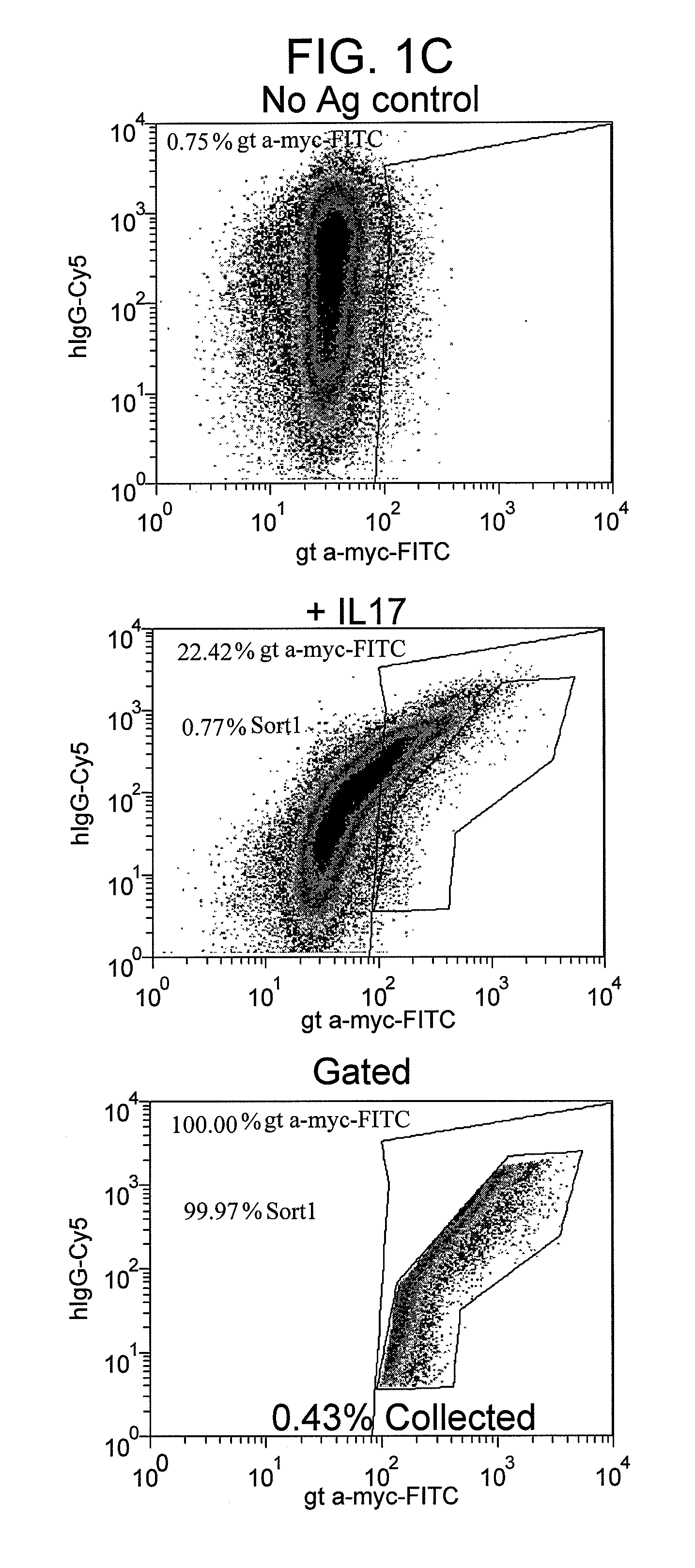Methods of generating improved antigen-binding agents using chain shuffling and optionally somatic hypermutation
- Summary
- Abstract
- Description
- Claims
- Application Information
AI Technical Summary
Benefits of technology
Problems solved by technology
Method used
Image
Examples
example 1
[0110]This example demonstrates a method for identifying cells which express an antigen-binding agent that binds to IL-17a in accordance with the inventive method.
[0111]A nucleic acid sequence encoding the heavy chain (HC) of a humanized reference IL-17 antibody, was cloned into an expression vector as described in, for example, U.S. Patent Application Publications 2009 / 0093024 A1 and 2009 / 0075378 A1. The expression vectors utilized in this example comprise pJ2 or pJ15 from DNA2.0 (Menlo Park, Calif.) as the vector backbone, and are described in more detail in U.S. Patent Application Publication 2009 / 0075378 A1. Briefly, the expression vectors contained the following elements operably linked together: (1) CMV promoter; (2) multicloning sites; (3) gene(s) of interest (e.g., a HC encoding gene); (4) terminator sequences, (3′ untranslated region, small intron and polyA signals from SV40 (“IVS pA”)); (5) Epstein Barr Virus (EBV) origin of replication (oriP) (preceded by optional interge...
example 2
[0117]This example describes a method of determining the nucleic acid sequences encoding second polypeptides comprising second component light chains, which together with a first component HCmature, form antigen-binding agents that bind to IL-17a with high affinity.
[0118]DNA was harvested from a portion of the positively gated cell population collected in round 1 and round 2 of the screen described in Example 1 by conventional methods (such as those described herein). Open reading frames of LCs were obtained by PCR, and the DNA sequences from individually cloned templates were obtained by conventional methods (such as those described herein). Alternatively, the episomal DNA harvested from a portion of the positively gated cell population was transformed into E. Coli, and DNA sequences from individual clones were obtained. A total of 187 DNA sequences were obtained from a portion of the positively gated cell population collected in the screen described in Example 1. The corresponding...
example 3
[0122]This example demonstrates a method for identifying cells which express antigen-binding agents that bind to IL-17a in accordance with the inventive method.
[0123]The nucleic acid sequence encoding the mature HC which subjected to SHM described in Example 1 was determined by standard methods (such as those described herein). The nucleic acid sequence of the germline sequence from which the mature HC was derived was also determined. A vector was then constructed comprising a “devolved” version of the mature HC wherein all or part of the variable region, except the CDR3 region, was devoid of SHM. This weaker version of the mature HC, termed “germline HC” or “HCgermline,” was then co-transfected into HEK293 cells along with the library of nucleic acids encoding kappa LCs described in Example 1. AID was pulsed transiently in the HEK293 cells before, during, and after the chain shuffling process.
[0124]In the first round of screening to identify HCgermline / LC combinations which togethe...
PUM
| Property | Measurement | Unit |
|---|---|---|
| Density | aaaaa | aaaaa |
| Affinity | aaaaa | aaaaa |
Abstract
Description
Claims
Application Information
 Login to view more
Login to view more - R&D Engineer
- R&D Manager
- IP Professional
- Industry Leading Data Capabilities
- Powerful AI technology
- Patent DNA Extraction
Browse by: Latest US Patents, China's latest patents, Technical Efficacy Thesaurus, Application Domain, Technology Topic.
© 2024 PatSnap. All rights reserved.Legal|Privacy policy|Modern Slavery Act Transparency Statement|Sitemap



